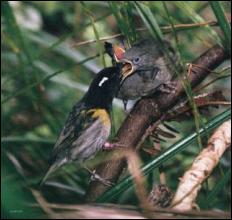Hihi chicks stretch their wings
18 November - Wellington
Forest & Bird media release
Hihi chicks stretch their
wings
 The first six hihi youngsters hatched this
spring at Ark in the Park in the Waitakere Ranges are off to
a flying start.
The first six hihi youngsters hatched this
spring at Ark in the Park in the Waitakere Ranges are off to
a flying start.
Their parents were some of the 120 endangered hihi, or stitchbirds, transferred from Tiritiri Matangi Island sanctuary during the past two years.
About five hihi nests have eggs or chicks at Ark in the Park - a Forest & Bird and Auckland Regional Council partnership. Hihi monitoring contractor Andy Warneford hopes for at least 20 hihi fledglings at the Ark this summer. "It's a huge step up from last season when about six chicks fledged," he says.
The hihi nests are 25 metres up mature kauri trees but the junior hihi are stretching their wings on the ground. Ark in the Park volunteer Laurence Bechet was trying to photograph them last week and had to wait while three bold fledglings hopped over her camera on the ground.
While the fledglings are learning to fly they stick together in creches. As they get better at flying they start following their parents.
To visit Ark in the Park to film or photograph the hihi fledglings, contact Andy Warneford, 09 810 8133, 021 644 853.
For Laurence Bechet's hi-res jpegs of the hihi fledglings, contact Communications Officer Marina Skinner, 04 801 2761, 021 792 260.
Hihi fast facts
* 60 hihi were transferred from Tiritiri Matangi Island sanctuary to Ark in the Park in February 2007 and another 60 were transferred in May 2008.
* Ark in the Park at Cascade Kauri Park in the Waitakere Ranges is a community restoration project by Forest and Bird and Auckland Regional Council.
* The hihi is one of New Zealand's rarest birds but was once found throughout the North Island. Introduced predators, habitat destruction and possibly disease reduced them to a small population on Hauturu/Little Barrier Island in the Hauraki Gulf.
* Hihi numbers on Tiritiri Matangi are stable but about half the birds die each winter, probably because of a lack of mature food-producing trees.
ENDS


 Gordon Campbell: On The Americanising Of NZ’s Public Health System
Gordon Campbell: On The Americanising Of NZ’s Public Health System Rio Tinto & NZAS: Archaeological Project Underway From Historic Excavations At Tiwai Point
Rio Tinto & NZAS: Archaeological Project Underway From Historic Excavations At Tiwai Point New Zealand Deerstalkers Association: NZDA Urges Hunters To Prioritise Safety This Roar Season
New Zealand Deerstalkers Association: NZDA Urges Hunters To Prioritise Safety This Roar Season PSA: 1000 Days Since Landmark Pay Equity Deal Expired - Workers Losing $145 A Week
PSA: 1000 Days Since Landmark Pay Equity Deal Expired - Workers Losing $145 A Week Grace Tinetali-Fiavaai, RNZ: Widow Of Fa'anānā Efeso Collins Seeks Inquiry Into His Death - 'Unanswered Questions'
Grace Tinetali-Fiavaai, RNZ: Widow Of Fa'anānā Efeso Collins Seeks Inquiry Into His Death - 'Unanswered Questions' Te Pāti Māori: Te Pāti Māori Call For Mandatory Police Body Cameras
Te Pāti Māori: Te Pāti Māori Call For Mandatory Police Body Cameras NZ First Party: NZ First Introduces the “Conscience Acts Referendums Bill”
NZ First Party: NZ First Introduces the “Conscience Acts Referendums Bill”


